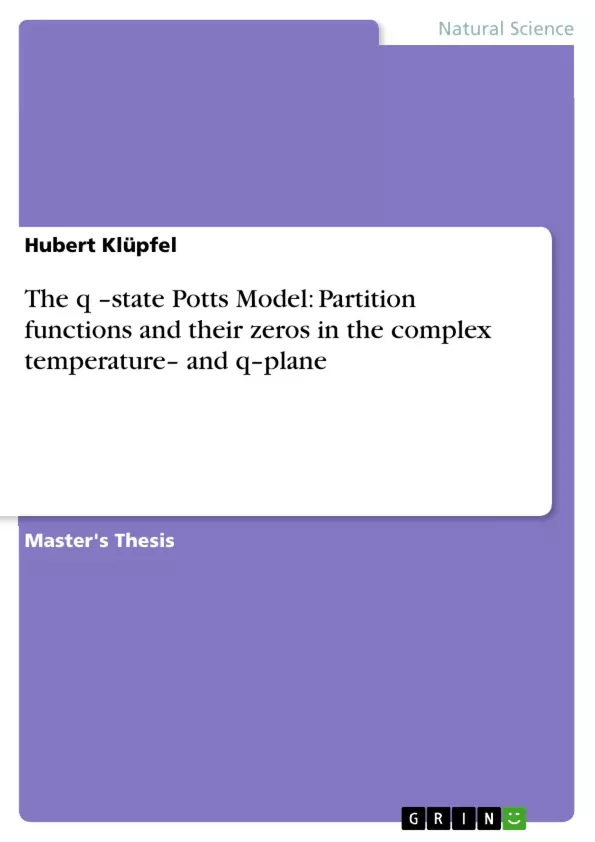In this thesis results on the Partition function ZG(T, q) for the q–state Potts–Model on finite polygonal lattices G are presented.
These are polynomials in a ≡ e− J and q. The first step is to calculate all the coefficients of ZG(a, q) using a transfer matrix method.
The only points of non–analyticity are the zeros of the partition function; in the thermodynamic limit the complex temperature zeros form a continuous curve B via coalescence. This is the locus where the free energy is non–analytic. The zeros of Z(a, q) in the complex q–plane for finite a and in the complex a–plane for integer and non–integer values of q are plotted.
For a = 0 the partition function reduces to the chromatic polynomial PG(q) of the graph and the zeros are called chromatic zeros.
The behavior of those zeros as a increases from zero is investigated.
As for complex temperature the zeros in q form a continuous curve in the thermodynamic limit. This is the locus where the limiting function WG(q) = limn→∞ PG(q)1/n is non–analytic. WG(q) is the ground state degeneracy and is connected to the ground state entropy via S0(G, q) = kB ln(WG(q)).
Thus the characteristics of the zeros of q and a for finite lattices help to understand the properties of the model in the thermodynamic limit.
Frequently asked questions about "The q-state Potts Model: Partition functions and their zeros in the complex temperature- and q-plane"
What is the central focus of this thesis?
This thesis investigates the properties of the q-state Potts Model by analyzing partition functions and their zeros in the complex temperature and q-plane, aiming to connect finite-lattice results with the thermodynamic limit.
What kind of model lattices are studied?
The thesis focuses on finite polygonal lattices, including square, triangular, honeycomb, and Kagome lattices.
What are the primary methods used for calculation?
The primary method is the transfer-matrix method, used to calculate the partition function, which is expressed as a polynomial in a = e^(-J/kT) and q. The method also exploits S_q symmetry to improve computational efficiency.
What are partition function zeros and why are they important?
Partition function zeros are points of non-analyticity. In the thermodynamic limit, these zeros form a continuous curve (B), where the free energy is non-analytic, indicating a phase transition. Their behavior in finite lattices helps understand model properties in the thermodynamic limit.
What is the relationship between the partition function and chromatic polynomials?
For a = 0 (zero temperature), the partition function reduces to the chromatic polynomial P_G(q) of the graph. Analyzing zeros in the complex q-plane provides insights into the ground state degeneracy and entropy via S_0(G, q) = k_B ln(W_G(q)).
What kind of boundary conditions are studied?
Primarily free boundary conditions are used. Periodic boundary conditions are also considered, especially in one direction to allow the use of the interface-method.
What is the duality property discussed in this thesis?
Duality relates a lattice G to its dual G_d, connecting high- and low-temperature partition functions. It also informs which boundary conditions conserve this relationship.
What is the influence of uniform coordination number and bipartite lattices?
If all lattice sites have an even coordination number, the partition function contains only even powers of 'a'. Bipartite lattices have two sub-lattices where spins interact only with those on the other sublattice, leading to additional symmetry properties and simplifications.
What's the major aim with the thesis?
It is attempted to combine previous research that has concentrated either on critical properties and complex temperature-zeros or on chromatic polynomials and ground state entropy to obtain results for both T and q variable.
What are the key findings regarding the location of the zeros?
The zeros in the q-plane form a continuous curve in the thermodynamic limit. Zeros can lie in the left half-plane ((q) < 0) for the square and triangular lattice if boundary conditions in the y-direction are periodic.
- Quote paper
- Hubert Klüpfel (Author), 1999, The q –state Potts Model: Partition functions and their zeros in the complex temperature– and q–plane, Munich, GRIN Verlag, https://www.hausarbeiten.de/document/201506


